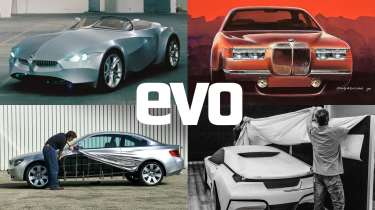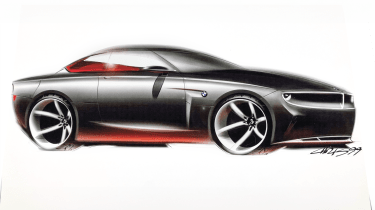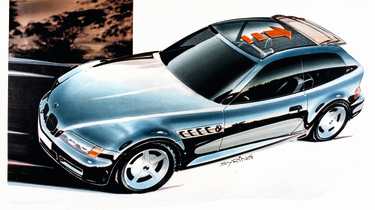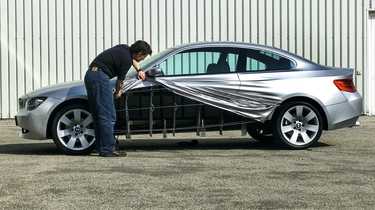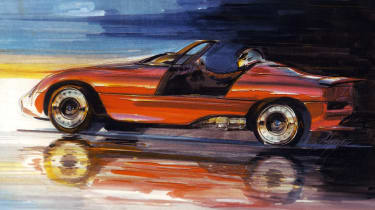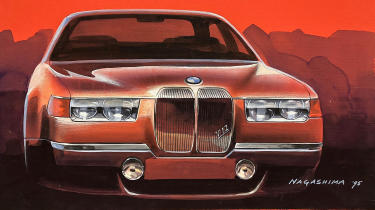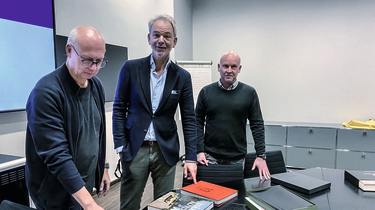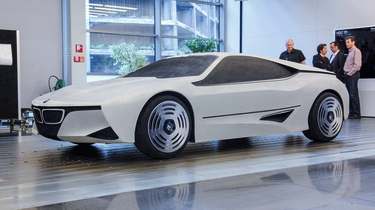Secret BMWs – a look behind the scenes at Munich's unseen models
For every BMW model that reaches the showroom, there are numerous prototypes and concepts that have existed only behind the scenes – until now
His Secret Fords books lifted the lid on countless fascinating Ford road car projects that never saw the light of day. Now Steve Saxty has turned his attention to BMW. In BMW by Design, Saxty unearths the stories behind some of the brand’s most iconic models, as well as many more that never made production. In this page, the author shares some of his favourite discoveries – along with a host of previously unseen images – to provide an insight into some of BMW’s design greats.
The road to the 1-series
The BMW 1M Coupé has always been an icon-in-waiting, but I hadn’t realised what a fascinating backstory it had. The idea kicked off in the mid-’90s as a skunkworks project – to reinvent the much-loved BMW 2002. I had only seen one photo of it but knew a number of people who worked on the project, codenamed 2K2 (a 2002 for the year 2002). Although lacking the overtly retro look of the Z8 or BMW Mini, designer Andreas Zapatinas conceived a 2002-style car featuring the shark-nose front of a classic ’70s BMW. It went nowhere until engineer (and 2002 owner) Ralf Langmeier asked design boss Chris Bangle if it could be used for a novel manufacturing idea he’d had.
The clever concept was to reskin the 3-series Coupé with a lightweight composite body and strip it of heavy, expensive components such as the bonnet gas struts and hi-fi to bring it in under 1000kg. Designer Thomas Plath updated Zapatinas’ design and the car was built into a fully drivable runner. To my delight, I found that the car still existed, and the team behind it were still – 20 years later – so passionate about their stillborn 2K2, even though it never made production.
Instead the idea mutated into the first-gen 1-series. The marketing people insisted it was launched as a hatchback, even though designer Chris Chapman conceived his 1-series as a coupe, effectively a son-of-2K2. The 1-series Coupé followed the hatch and eventually led to the 1M Coupé. Here is the CS1 show car, revealed as a convertible so that nobody could guess the roof shape and four per cent smaller in every dimension to trick showgoers into thinking the production car was going to be a tight fit.
> Rimac to supply BMW with EV batteries
Send in the clown shoe
The story behind the ’90s Z3 Coupé is delightfully romantic. The Z3 was intended to be made as a four-cylinder-only convertible to compete with the MX-5, but engineer Burkhard Göschel wanted a six-cylinder M-powered car with stronger coupe bodywork. He turned to design boss Chris Bangle who loved the idea, and so three designers submitted ideas and one by junior M designer Markus Syring was selected.
Back in summer last year, Markus told me he had a huge folder of his work that had not been seen, ‘for when you write the Secret BMWs book, Steve’. Amongst them were Markus’s Z3 Coupé sketches and we got chatting. ‘We couldn’t justify the extra cost for the coupe of a unique body side pressing from A-post to rear fender just to incorporate the Hofmeister kink you see here,’ he told me. ‘Instead, production cars had a unique rear fender that, like the roadster’s, was a bolt-on panel that mated up to the C-pillar.’
The rear lights were also changed for the coupe. ‘I got a call summoning me to the Aschheim test track where they had a prototype running,’ Marcus says. ‘And there’s little me, in my mid-20s, with Dr Göschel and Dr Reitzle. They asked me what I thought about the carryover roadster rear lights on the coupe prototype and I said that they looked like a squashed hamburger. Reitzle turns to me and says: “OK – you’ve got two million Deutsche Marks; change it!”’
Stories like this strike a chord with me, and I’m not alone; one morning my book designer, Adrian Morris, sent me a WhatsApp: ‘Look, I just bought a Z3 because of that chapter!’
There’s more than one way to skin a car
I hadn’t expected people to get so misty-eyed over Gina. When it was revealed in 2007, the fabric-bodied car seemed, well, a bit strange. BMW was already moving on from the contorted ‘flame surfacing’ of the early 2000s, yet here was a car with twisted fabric surfaces. What I hadn’t realised was that it dated back five years earlier to 2002 and left far more of a mark on BMW than any of us knew at the time.
Like all the best ideas, it was born in a bar where a lady – named Gina, of course – was twirling fabric as part of her dance act. The idea was alluring: what if car bodywork could be made from fabric? It’s not as daft as it sounds; fabric is lighter than metal, it doesn’t need expensive tooling and, of course, it’s highly flexible, permitting shapes, features and folded surfaces impossible in a solid material.
When I started my research, I was given a huge trove of images: ‘Gina-generators’ used to create fabric-surfaced shapes of dashboards and zip-up covers for under-bonnet components. Perhaps most amazing were two photos of an E93 coupe using Gina-style fabric surfacing that was a genuine proposal for the late-2000s car. These images revealed a drivable machine based on a Z8 prototype.
There’s one Gina legacy that did reach production: the Z4 M Coupé featured a modified bonnet that distinguished the M version from regular Z4 models. Here, two creases were added along the length of the bonnet using a robotic sweep of a tool that scribed them into the metal. Before Gina, such thinking would have required a far more expensive stamping tool to achieve the same result.
Evolution of the sketches
One of the most difficult tasks in completing a book – apart from selecting the cover and writing the intro – is to find a powerful image to open Chapter 1. I knew what I wanted: to please the classic enthusiasts and owners of modern BMWs equally. The answer was to find a matching pair of design sketches from the ’70s and the near-present. The throbbing orange BMW 2002 was the perfect choice, pairing it with an almost perfectly complementary blue and orange sketch of the 2002 Hommage from a few years ago. That way readers could see the contrast between the draughtsman-like precision of the ’70s compared to the digitally colour-saturated images of today.
The 2002 was drawn by Manfred Rennen, who joined BMW in the mid-’60s and worked as a stylist for over two decades. His rendering shows every detail, right down to the screws on the wheelarches, the whole thing brought to life on vivid orange Canson paper.
Other sketches in the book reveal further techniques, such as the depiction of the Z1 as a stripped-to-the-bone roadster, drawn in the mid-’80s by Stefan Stark. For this, Stark used chalk and marker on vellum paper. ‘My intention was to come up with a dynamic and beautiful atmosphere, the sort of vibe you get when you drive out of a rain shower back into the sun,’ he says.
The M8 convertible was drawn by its designer Jacek Peplowski. ‘I painted rather than sketched it,’ he says, ‘while trying to capture the mechanical muscles lurking beneath the skin, ready to deliver the car’s performance. The colours were inspired by late evening visits to the Californian desert, where sunset displays an incredible range of tones. And the car… it’s almost as though its presence would heat up the environment to a sun-like temperature.’
The eternal quest of the 9-series
Sometimes I felt like I was writing a thriller laden with plot twists as the decades passed, car designs lived and died, and the designers and execs came and went. One of the recurring themes was BMW’s eternal quest to fill the yawning space above the 7-series and below the Rolls-Royce models – call it the 9, or even the 11-series space. It’s no mystery why BMW would want a presence in that £170k-£300k price range, for that’s exactly where Bentley sits.
In the mid-’90s BMW began its tie-up with Rolls-Royce/Bentley to supply V8 and V12 engines. At the same time, the design team began thinking about how a more premium 7-series might look in the 2000s. Above is designer Joji Nagashima’s idea for an upmarket V12-powered BMW, long before Rolls-Royce became a BMW brand.
After BMW acquired Rolls-Royce the product planners began thinking about a premium platform that could underpin a super high-end BMW and a more affordable Rolls-Royce. The Concept Coupé, slated for production under the codename F05, was to have spawned a premium BMW coupe, convertible and four-door. Sadly, the production version of this stunning one-off show car by current Kia design boss Karim Habib was cancelled after the economy crashed in 2008.
Orange is the new black
There are two reasons why the three-book set of BMW Behind The Scenes has a bright orange cover. When I met Adrian van Hooydonk, I quickly discovered that BMW’s chief designer is – like all his team – an enthusiast for car books and, in particular, car book design. One Tuesday night over dinner, Adrian asked me: ‘Do you think your book designer would be willing to fly over and chat? How about Thursday?’
This was when I asked: ‘So what colour should we make it?’ The tall Dutchman replied: ‘Orange, of course!’ And he went on: ‘I really do like orange by the way, not just because I’m from Holland! Even one of my classic BMWs is that colour.’ Adrian has a dry sense of humour, so I wondered how serious he was until one of the designers told me: ‘I once tried to draw my ideas up in orange, but Adrian is too smart for that and he knew exactly what I was up to!’
The other story around the colour orange goes back decades and is one I’m pleased to have discovered. Paul Bracq is the legendary BMW design chief from the early ’70s; when we discovered a load of his work that had never been seen in print, I made contact with him. One of his most celebrated creations is the E25 Turbo show car from 1972, with a ruby red body with volcanic orange front and rear bumpers. The red was the same colour as his Porsche 356, but the orange? It was inspired by the French Air Force trainer jets outside his old studio, painted with Day-Glo orange ‘safety paint’. When they started using orange stickers, Paul asked for the unused paint, which eventually became an iconic BMW colour.
From V10 to i8
Werner Haumayr is one of the most senior people in BMW Design. One day we were chatting away, and he laughed: ‘I reckon that every day there’s someone in this place sketching away designing an M1 under their desk. You could do a book on the M1s we never made!’
Werner is probably right. One of the revelations in BMW by Design is Project I16, the never-seen version of the Vision M Next that was 95 per cent production-ready as a 2023 latter-day supercar.
The car pictured above, on the other hand, did break cover. It’s the M1 Hommage – but not as we know it. The 2008 show car was revealed in a throbbing red colour, was made of solid resin, and the whole project was completed in just four months. How did the design team do it? Today it’s more common, but 16 years ago it was a radical idea to sketch a design digitally and then mill it out of a giant block of foam. That’s why this car is white – it was made from Styrofoam and was used to evaluate the design at full size within weeks of getting started.
The M1 Hommage was intended to hit the road; I was given engineering drawings for it to put in the book, showing where the engine would have gone. And what an engine it was, nothing less than the legendary F1-derived V10 motor fitted to the contemporary M5. Perhaps sadly for fans of M-powered sports cars, the project went no further – the V10 was too tight a fit in the M1 Hommage without a major redesign. And when that redesign came, BMW changed direction and responded to critics who said it should make more eco-friendly cars – the result was the hybrid-powered BMW Vision EfficientDynamics that spawned the hybrid i8. – Steve Saxty
This story was first featured in evo issue 319.
BMW by Design tells the story of the company’s design department, its stylists and the cars they have created, across the decades. The book can be purchased on its own for £79.95, or as part of BMW Behind The Scenes, a three-book set that also features BMW’s Hidden Gems, revealing untold stories and unseen BMWs, plus BMW Art by Design, which takes readers through a gallery of design sketches, narrated by the BMW designers that drew them.
